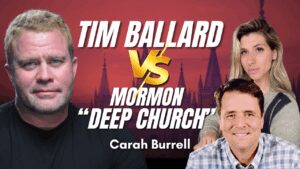To keep this podcast alive, please consider donating to Mormon Stories by clicking on the “Make a Donation” button at the top right of this blog.
Well, it’s been a long time coming, but I’m finally ready to bring back Mormon Stories Podcast. Thanks for your patience.
As many of you know, Deseret Book recently decided to acquire Seagull Book and Tape and Covenant Communications — 2 of Deseret Book’s top competitors in the LDS book publishing and retail market.
In parts 1 and 2 of a series on this topic, LDS book publisher Kent Larsen of https://www.mormonpavillion.com and https://www.motleyvision.org discusses the history of the LDS book industry, and his views on the implications of this acquisition.
Part 1
Part 2




22 Responses
Are these two episodes combined as one when you download from iTunes? I just downloaded episode 38 from itunes– no 36 or 37.
37 and 38 should be there. They’re separate.
OK, I found them, just wasn’t looking hard enough before. Thanks
In my non-existant knowledge of this business, I was left wondering why Kent was so insistent on Brick and Mortar models. I would think a conglomerate of independant publishers using a web store, LDSbooks.com? would be the most viable model in the future. They could then advertise at Fair/Farms, Mormon stories of course, DMI, and various bloggernacle sites. While the Church right now may not use the internet this way, It is the way of the future.
With respect to a prosperous church abroad, Ken Larsen has figured it out.
It’s not exactly rocket science. If you want to take roots uproad than you cannot centralize everything in Salt Lake.
The Pentecostals who are much more successful anywhere in the world leave publications entirely to national staff. The central organization only sees to it that publications remain orthodox. Anything else is left up to nationals.
That suggests that Larsen may not go far enough. Translate as little as necessary and produce as much as possible nationally.
John,
The problem with an “independent” Mormon book store is that mainstream Mormons don’t want to read anything other than those books sold at DB. My view may be tainted in that I live in AZ but from what I know of Mormon culture in the Western US, people are fairly homogenized. The culture is strong and the fear of reading anything that is not within cultural boundaries is seen as anti or even apostate. My Mother has worked at DB for 20 years. I worked there after my mission. The section of “good” books is slim and getting slimmer. Many of the Signature books that I bought there in the early 90’s are not there any more.
John
Great thought John. I have found also that for many members their religion is only something they think about when they are at Church or doing church related things. With that in mind I am not surprised that many don’t want anything other then what comes from DB or the Church. On the other I am grateful that there were Leonard Arrington’s are Richard Bushman’s who write good books despite the fact that few members of the Church will read their books.
Doc:
There are at least two reasons why I concentrated on brick and mortar stores in my analysis.
First, the acquisition of Seagull Books is all about brick and mortar stores. The two companies competed in brick and mortar, and the acquisition’s most important effect is in its brick and mortar stores.
Second, as I think we tried to cover in the podcast, brick and mortar stores is where the sales are, at least at the moment.
The problem with using the Internet to solve problems like this is simply that only a minority of LDS Church members use the Internet for religious reasons. This is one reason why use of stake and ward websites is generally less than 10% of active members.
By my back of the envelope estimate, 5% of the active Church members in the US would be some 100,000 people (less if you exclude children). Does the amount of participation in the Bloggernacle and other LDS Internet resources suggest that anything close to these numbers is visiting on a weekly basis?
This is even true of the Internet in general. Yes we’re closing on a majority of people using the Internet, but not everyone makes purchases there. Internet sales of books, for example, account for only about 10% of book sales in the US (if my memory of what I read about this is correct).
I do agree that the Internet will continue to be a major factor, and may even eventually account for a significant portion of book sales in the LDS market. But I suspect that this could be a decade or more away. I’m not sure on-line book stores like Amazon.com will ever account for the majority of book sales. A lot of people like the bookstore experience, and will make a significant portion of sales there.
Having said that, however, I do think that such a cooperative bookstore would work, and a good independent online store could work also. Deseret Book’s website isn’t that good (not compared to Amazon and B&N’s websites), and every other LDS book website is really substandard. I believe my own site Mormon Pavillion is functionally much better than Seagull’s site — it just doesn’t have the number of products that Seagull does. [Feel free to tell me how I’m wrong.]
So, you are correct, Doc, in believing there is an opportunity in Internet book retail.
Helmut, thank you for your kind words!
For those interested in more depth about the language issue, you can see my post about language issues on Motley Vision. You should also then subscribe to Motley Vision’s feed, since I expect to follow up on this issue in the next few weeks.
This Christmas, Ryan Yonk gave me a copy of “Added Upon”, 1918 printing for Christmas. I had no idea it was in print for a century!
I think i must agree with those who have articulated the position that most members are reluctant to read books that do not come from DB or written by a GA or BYU “theologian”. I would argue that this is a very sad byproduct of correlation, that our culture has now taught most members that the only trustworthy and good sources of doctrine, history, culture and information comes from the Correlation Committee in Salt Lake City.
The effect upon history in particular, is the “Disneyization” of our historical narrative. Perhaps the best example is the “Work and the Glory” series where Gerald Lund took serious liberties in what he chose to include, emphasize and completely eliminate from his books. Because Lund is a GA, he is immediately accepted as a historical authority, perhaps even more so than people like Bushman and Arrington. As a result, important dimensions of our history are lost, and misunderstood. Most members now get their Church history from the Mickey Mouse Work and the Glory series, sincerely believing what they have is accurate.
We have seen thousands of personal accounts on the internet of people who beleived the Disney LDS History, find the real history and lose faith. This is completely avoidable if the Church would gradually move towards a more accurate and truthful history.
But to do that, they need pluralism, and to have pluralism, we have to get rid of the cultural paradigm that attaches the historical intellect of the members to the proverbial teet of correlation.
Our culture, history and doctrine are not being fully expressed through mass media because faithful members only trust correlation- which reduces Mormonism to the lowest common denominator.
I truly wish Kent Larsen the best in his pursuits, as they will only end up deepening and enriching Mormonism
Tom:
Thank you for your kind words.
I’m waiting for that (hopefully inevitable) history of correlation in the Church. It should indeed be a fascinating insight into both what decisions the Brethren have made, and into many cultural changes in Mormonism over time.
Please, someone write this book soon!!
Kent, You mentioned that profits from DB and other church businesses go back for church use. I just wondered if we actually know that for sure. I thought that the business operations were mostly separate from church stuff, and profits would just go back into the individual businesses. Is there any actual financial disclosure showing that the profits benefit the church?
Also, do you have a sense of how well DB is doing as a business? In a conversation with a DB employee a year or so ago, I got the impression that perhaps things weren’t as rosy as I thought. She said that there were very few people who actually were guaranteed sellers in the mormon market, so it’s hard for them to take a chance on new authors.
Paula:
You are correct. As private businesses, none of the businesses owned by the LDS Church’s Deseret Management (the organization that owsn the Church’s for-profit businesses) are required to report their earnings to the public in any way. So we have no way of knowing if they turned a profit, how much of a profit it was or how much was returned to the Church.
The sense that I have from news reports and from the few people that I’ve talked to is that DB isn’t doing as well as Deseret Management had hoped.
But I have no idea what that means. Are Deseret Management’s expectations realistic? Is Deseret Book doing better or worse than publicly traded book stores and publishers? We just don’t know.
Thanks Kent. I would have thought from the ads and catalogs that Deseret Book was doing well, cranking out the mormon market books and had always assumed it was doing well, till I had that conversation.
Another question, if you don’t mind me asking– why did you quit doing mormonnews?
I stopped mormon news at the time I purchased another business I run, Luso-Brazilian Books. I do have a hope of starting Mormon News again, with software that supports more user contributions. As soon as my service provider does the upgrade I requested last week, I should be in alpha testing on the new software system. It will probably be at least 3 to 6 months before anything is live, however.
Kent, I served in the Brazil Recife Mission and am interested in checking out your site, but it currently isn’t displaying any content. Has it launched yet?
Kent, I’m glad to hear it will be back. I liked having the variety of news, without it being filtered as to whether or not it was faith-promoting or positive.
Brian:
You happened to check the site at the same time that an upgrade was being done. Its back to normal now.
You stated that the church members need culture and used the example of Mormon choirs aside from the MoTab choir. Perhaps you are not aware that the Arizona Mormon Choir you cited as an example was disbanded at the request of the church in 2006.
Do we know why it was disbanded?